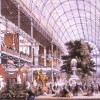 Held from May to October of 1851, “The Great Exhibition of the Works of Industry of All Nations” was opened by Queen Victoria in the structure built to house it, the
Held from May to October of 1851, “The Great Exhibition of the Works of Industry of All Nations” was opened by Queen Victoria in the structure built to house it, the ![]() Crystal Palace, in Hyde Park (click for geospatial location), London. Image: Interior view of the Crystal Palace in Hyde Park, London during the Great Exhibition of 1851. This image is in the public domain in the United States because its copyright has expired.
Crystal Palace, in Hyde Park (click for geospatial location), London. Image: Interior view of the Crystal Palace in Hyde Park, London during the Great Exhibition of 1851. This image is in the public domain in the United States because its copyright has expired.
The Great Exhibition of 1851 was an event in the history of: exhibitions; world’s fairs; consumerism; imperialism; architecture; collections; things; glass and material culture in general; visual culture; attention and inattention; distraction. Its ostensible purposes, as stated by the organizing commission and various promoters, most notably Prince Albert, were chiefly to celebrate the industry and ingeniousness of various world cultures, primarily the British, and to inform and educate the public about the achievement, workmanship, science and industry that produced the numerous and multifarious objects and technologies on display. Designed by Joseph Paxton, the Crystal Palace (pictured above) was a structure of iron and glass conceptually derived from greenhouses and railway stations, but also resembling the shopping arcades of Paris and London. The Great Exhibition of the Works of Industry of All Nations became a model for World’s Fairs, by which invited nations showcased the best in manufacturing, design, and art, well into the twentieth century.
Articles
Audrey Jaffe, “On the Great Exhibition”
Related Articles
Aviva Briefel, “On the 1886 Colonial and Indian Exhibition”
Anne Helmreich, “On the Opening of the Crystal Palace at Sydenham, 1854″
Anne Clendinning, “On The British Empire Exhibition, 1924-25″
Barbara Leckie, “Prince Albert’s Exhibition Model Dwellings”
Carol Senf, “‘The Fiddler of the Reels’: Hardy’s Reflection on the Past”
